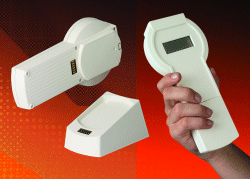Beginning early in the design process is paramount to success
TBY RALPH RAIOLAEditor, Electronic Products
From battery backup and power supplies to portable blood-pressure monitors to dialysis and EKG machines, devices destined for medical environments present EEs with a variety of design challenges based on very specific needs and requirements. Every part specification is an important one. So, it follows that a designer choosing an enclosure should spend more than a little time and effort to find the one that fits correctly, so to speak.
Moreover, enclosure professionals believe that selecting a housing should not be relegated to the end of the design process. “The enclosure should be one of the first thoughts [of the designer], once the connectors, user interface and power requirement have been determined,” said Sean Bailey, vice president, sales, OKW Enclosures (Bridgeville, PA). “It should be done definitely before the PC-board layout is considered.”
Blair Haas, president, Bud Industries (Willoughby, OH), agrees and takes this point even further. “Our research shows that enclosures are one of the last elements included in their design and review process,” he said. “This means that the design process is now constrained by the available time and a less than ideal enclosure may be selected in order to meet deadlines.”
First step
The first step a designer needs to take in the hunt for the right enclosure is to decide how the end-product/design will be used. It may be portable/handheld, stationary (on a bedside table or portable cart, or mounted (either to the bed, an IV pole, or to the patient. Functionality and intended location, then, go hand in hand and many times need to be considered as such.

According to Haas, functionality is important in any location but appearance and configuration can change based upon the location. For example, in a lab environment function is the primary concern, whereas in a patient’s room, in addition to functional elements, the designer needs to anticipate visual concerns and fluid protection.
Knowing how the design will function and operate is paramount, however, to proper selection. Bailey asserts that EEs should keep in mind such parameters as:
• The ideal size of the final product
• Required display or user interface
• Connector types for I/O devices
• Power requirements
Marc Caiola, a market segment manager for Pentair Electronic Packaging (Poway, CA) advises the design engineer keep in mind the following:
• Is the equipment 19-in. rack mountable?
• Are there any shielding requirements?
• Are there any environmental issues/requirements—for example, explosion proof, thermal insulation, cleaning/wash down requirements, or dust issues?
• How much heat is the equipment generating?
• Security needs
• Does the enclosure need to be portable?
Look and feel
Newer medical devices can have, and even may require, interesting and simple shapes. An old fashioned square box will not give the perception of an innovative new product, but the opposite.
The surfaces must be pleasant to the touch and easy to clean, to keep sterile. The corners and curves must have clean lines with no areas where dirt or bacteria can hide.
Standards and testing
For obvious reasons, the medical electronics market is governed by various domestic or international standards and regulations. But these standards and regulations often change depending on the product being designed as well as where it will be used.
Different characteristics of a medical enclosure may be held to different specifications. For instance, a plastic may need to adhere to UL 94V-0 flammability ratings, or even specialized sterilization capabilities. IP 65/NEMA 4 ratings govern things like water and dust ingression, an obvious concern in medical environments where fluids and other liquids can upset electronic circuits.
Like any device, medical equipment and components will be tested first to verify that it actually functions. There will be initial ‘approval’ testing by UL, FCC, CE, etc.
There maybe several different tests by each Certification Body (eg. Material Flammability, EMI/RFI). All testing authorities relevant to where the product will be sold/used (e.g. UL and FCC for the U.S., CE and British Standards for U.K).
“The amount and type of testing will depend on the end application, how much work is being done on the enclosure after it leaves the manufacturer, and what the end customer’s requirements are,” said Susan Gangsei, a marketing director at Pentair. Typically, products are required to be tested in their final usable configuration. Since many enclosures will have electronics and other parts integrated by the OEM customer, many tests done at the enclosure manufacturer are not relevant to the final design.”
Many OEM customers will require that an enclosure be “designed to meet” or actually be tested to meet certain specifications in order to gain confidence that the final assembly will pass whatever testing is required for the application.
Typical testing that enclosure manufacturers will conduct includes:
• Shielding effectiveness
• Shock, vibration, seismic
• Environmental tests
• Thermal, airflow, and cooling modeling and analysis
Materials
Steel, plastic, and fiberglass are the most prevalent enclosure materials. The material specified depends on the function of the unit and the cost/value benefit.
Smaller enclosures are typically made of plastic, which allows manufacturers to take advantage of the style options of molded plastic. Steel is the material of choice for larger enclosures where heavier weight bearing requirements exist. On occasion the designer’s preference or marketing considerations will drive the decision.
Shielding against EMI/RFI
Occasionally, enclosure specifiers will request the unit to be shielded against for EMI/RFI, Haas said. He contends, however, it is usually more cost effective and efficient for the specific “noisy” components to be shielded.
In smaller enclosures where this might not be viable, the shielding techniques vary according to the enclosure material. In a plastic enclosure, the inside of the box can be coated with metallic shielding materials that provide the required level of protection. In larger metal enclosures, gasketing is required. ■
Advertisement
Learn more about Electronic Products Magazine





